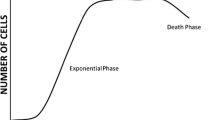Summary
We have compared several methods for reducing calcium and magnesium concentrations in tissue culture medium, with the objective of producing selective deficiency effects on the growth of mouse (L5178Y) and human (P1R) lymphoblasts. In experiments in which calcium- and magnesium-“free” McCoy’s medium was supplemented with 15% horse or fetal calf serum, enough calcium and magnesium was provided by serum to support normal lymphoblast growth rate. Either dialysis or chelating-resin treatment of horse or fetal calf serum reduced calcium and magnesium contents approximately 100-fold. Use of dialyzed sera resulted in reduced growth rate, although in most cases the reduction in growth could be attributed to other effects of dialysis on serum, inasmuch as growth in those experiments was not restored to normal by the addition of calcium and magnesium to the medium.
In contrast, the reduction of lymphoblast growth rate that occurred when resin-treated serum was used was always attributable to removal of calcium and magnesium, as normal growth always occurred in cultures to which calcium and magnesium were added.
To demonstrate a growth-inhibiting effect on either mouse or human lymphoblasts by severe reduction of either calcium or magnesium in the presence of normal amounts of the alternative cation, it was necessary to (a) expose McCoy’s Ca−Mg-“free” medium to chelating-resin to reduce further the residual cation concentrations; (b) wash cells from stock cultures in a medium devoid of calcium and magnesium prior to inoculation into experimental cultures; (c) reduce the proportion of serum in the final medium from 15 to 5%; and (d) add 100 μM EGTA to cultures. Under these conditions, growth of both cell types was completely abolished in the presence of normal magnesium but in the absence of added calcium, and markedly reduced in the presence of normal calcium but in the absence of magnesium. These modifications did not compromise growth in cultures containing normal concentrations of both ions.
Similar content being viewed by others
References
Brennan, J. K., and M. A. Lichtman. 1973. The effect of extracellular calcium and magnesium on the proliferation of murine lymphoblasts. J. Cell Physiol. 82: 101–112.
Owens, O. v. H., M. K. Gey and G. O. Gey. 1958. The effect of calcium and magnesium on the growth and morphology of mouse lymphoblasts (MB III, de Bruyn) in tissue culture. Cancer Res. 18: 968–973.
Separating metals using Chelex 100 chelating resin. 1964. Calbiochem Technical Bulletin 114: 1–3.
Schmuckler, G. 1965. Chelating resins—their analytical properties and applications. Talanta 12: 281–290.
Auger, M. A., P. Tiollais, and M. F. Jayle. 1971. Influence de glycoprotéines sur la croissance d’une lignée lymphoide en culture continué. Rev. Eur. Etud. Clin. Biol. 16: 130–135.
Whitfield, J. F., A. D. Perris, and T. Youdale. 1969. The calcium-mediated promotion of mitotic activity in rat thymocyte populations by growth hormone, neurohormones, parathyroid hormone and prolactin. J. Cell. Physiol. 73: 203–211.
Johnson, G. J., and P. S. Russell. 1965. Reactions of human lymphocytes in culture to components of the medium. Nature 208: 343–345.
Woodliff, H. J., and P. Onesti. 1968. Blastoid transformation of lymphocytesin vitro: the stimulatory effect of fetal calf serum. Med. J. Aust. 1: 1089–1091.
Hsu, C. C. S., W. I. Waithe, P. Hathaway, and K. Hirschhorn. 1973. The effects of foetuin on lymphocytes: lymphocyte-stimulating property. Clin. Exp. Immunol. 15: 427–434.
Havemann, K., H. M. Dosch, and S. Bürger. 1970. Phythämagglutinin (PHA) und Serumproteine in der Lymphocytenkultur. I. Nachweis von fördernden und hemmenden Serumfaktoren. Z. Gesamte Exp. Med. 153: 297–307.
Vogt, A., R. I. Mishell, and R. W. Dutton. 1969. Stimulation of DNA synthesis in cultures of mouse spleen suspensions by bovine transferrin. Exp. Cell Res. 54: 195–200.
Tormey, D. C., R. C. Imrie, and G. C. Mueller. 1972. Identification of transferrin as a lymphocyte growth promoter in human serum. Exp. Cell Res. 74: 163–169.
Piez, K. A., V. I. Oyama, L. Levintow, and H. Eagle. 1960. Proteolysis in stored serum and its possible significance in cell culture. Nature 188: 59–60.
Wein, J., and I. E. Goetz. 1973. Asparaginase and glutaminase activities in culture medium containing dialyzed fetal calf serum. In Vitro 9: 186–193.
Author information
Authors and Affiliations
Additional information
This work has been supported by a Research Grant from the U.S. Public Health Service (CA 12790), from the Monroe County Cancer and Leukemia Association, and by a contract from the Atomic Energy Project at the University of Rochester, and has been assigned publication no. UR-3490-624.
Rights and permissions
About this article
Cite this article
Brennan, J.K., Mansky, J., Roberts, G. et al. Improved methods for reducing calcium and magnesium concentrations in tissue culture medium: Application to studies of lymphoblast proliferation in vitro. In Vitro 11, 354–360 (1975). https://doi.org/10.1007/BF02616371
Issue Date:
DOI: https://doi.org/10.1007/BF02616371




